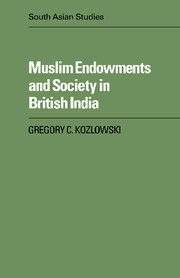Book contents
- Frontmatter
- Contents
- Acknowledgments
- Note on transliteration
- Abbreviations
- Introduction
- 1 Endowments in Muslim history, an overview
- 2 Muslim endowments and the temporal order in British India
- 3 Endowments and the faith
- 4 The unsettling of endowments
- 5 Creating a law of Muslim endowments
- 6 Muslim endowments and the politics of religious law
- Conclusion
- Bibliography
- Index
- CAMBRIDGE SOUTH ASIAN STUDIES
5 - Creating a law of Muslim endowments
Published online by Cambridge University Press: 25 October 2011
- Frontmatter
- Contents
- Acknowledgments
- Note on transliteration
- Abbreviations
- Introduction
- 1 Endowments in Muslim history, an overview
- 2 Muslim endowments and the temporal order in British India
- 3 Endowments and the faith
- 4 The unsettling of endowments
- 5 Creating a law of Muslim endowments
- 6 Muslim endowments and the politics of religious law
- Conclusion
- Bibliography
- Index
- CAMBRIDGE SOUTH ASIAN STUDIES
Summary
“The Law” is often taken as a given, and its development largely explained in terms of its own internal logic. This perspective, however, makes the historian uncomfortable, for it implies that the logic of the law is separable from the society in which it operates.
John BrewerThough they stood at the apex of the British empire's judicial pyramid, the Law Lords of the Privy Council dispensed with the usual panoply of periwig, gown and sash. The simplicity of the image which their Lordships presented, dressed in ordinary suits, meeting around a plain table in an unadorned room, gave little indication of the power they possessed. Since the sovereign invariably issued a special decree confirming their judgments, their word was, quite literally, law.
On three separate days in November and December of 1894, five of the Law Lords turned their attention to a case involving a number of persons living in the Sylhet district of north-eastern Bengal Province. The case came labelled in the customary shorthand of judicial reporting: “Abdul Fata Mahommed Ishak (and others) v. Russamqy Dhur Chowdhry (and others)”. Their Lordships never met the parties involved. As a court of appeals, the Privy Council heard no witnesses. It produced a decision based on lower court records, its own members' knowledge of the law, their lengthy judicial experience and the arguments of advocates representing the opposing parties.
Because Abd ul-Fatah's case involved an institution with an Arabic name, “waqf” Councillors knew at once that the case required a verdict according to what they called, “Muhammadan law”.
- Type
- Chapter
- Information
- Muslim Endowments and Society in British India , pp. 96 - 155Publisher: Cambridge University PressPrint publication year: 1985
- 1
- Cited by

